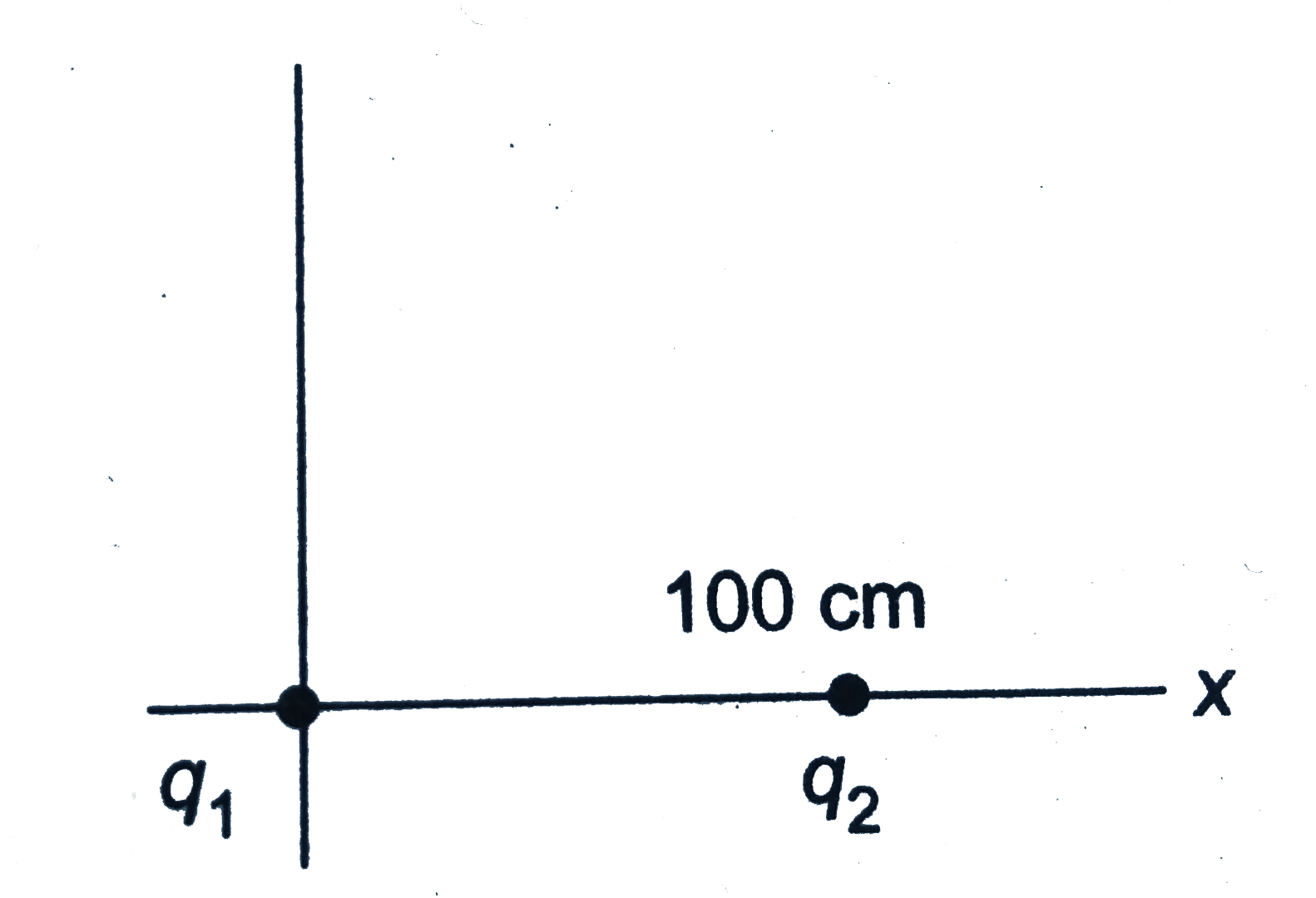Electric potential is a scalar quantity. Due to a point charge charge q at distance r, the potential is given by V=q4π∈0r. A point charge q is placed at (3a,0) and another charge −2q is placed at (−3a,0).
At how many points on the x-axis, (at finite distance) electric potential will be zero?
1
2
3
4
The correct Answer is:B
To determine the points on the x-axis where the electric potential is zero due to the given point charges, we can follow these steps:
Step 1: Understand the Setup
We have two point charges:
- Charge q located at (3a,0)
- Charge −2q located at (−3a,0)
Step 2: Write the Expression for Electric Potential
The electric potential V at a point P(x,0) due to a point charge Q is given by:
V=Q4πϵ0r
where r is the distance from the charge to the point where we want to calculate the potential.
Step 3: Calculate the Distances
For a point P(x,0):
- The distance from charge q at (3a,0) is r1=|x−3a|
- The distance from charge −2q at (−3a,0) is r2=|x+3a|
Step 4: Write the Total Electric Potential at Point P
The total electric potential V at point P is the sum of the potentials due to both charges:
V=Vq+V−2q=q4πϵ0|x−3a|+−2q4πϵ0|x+3a|
Setting V=0:
q|x−3a|−2q|x+3a|=0
Step 5: Simplify the Equation
We can cancel q (assuming q≠0):
1|x−3a|=2|x+3a|
Cross-multiplying gives:
|x+3a|=2|x−3a|
Step 6: Consider Different Cases for x
Case 1: x>3a
In this case, both distances are positive:
x+3a=2(x−3a)
Solving gives:
x+3a=2x−6a⟹x=9a
Case 2: −3a<x<3a
Here, |x−3a|=3a−x and |x+3a|=x+3a:
x+3a=2(3a−x)
Solving gives:
x+3a=6a−2x⟹3x=3a⟹x=a
Case 3: x<−3a
In this case, both distances are negative:
−(x+3a)=2(−x+3a)
This leads to:
−x−3a=−2x+6a⟹x=−9a
However, this point is not at a finite distance since we are only considering points on the x-axis.
Step 7: Conclusion
The electric potential is zero at two points on the x-axis:
1. x=9a
2. x=a
Thus, the answer is that the electric potential will be zero at two points on the x-axis.
---
We have two point charges:
- Charge q located at (3a,0)
- Charge −2q located at (−3a,0)
The electric potential V at a point P(x,0) due to a point charge Q is given by:
V=Q4πϵ0r
where r is the distance from the charge to the point where we want to calculate the potential.
For a point P(x,0):
- The distance from charge q at (3a,0) is r1=|x−3a|
- The distance from charge −2q at (−3a,0) is r2=|x+3a|
The total electric potential V at point P is the sum of the potentials due to both charges:
V=Vq+V−2q=q4πϵ0|x−3a|+−2q4πϵ0|x+3a|
Setting V=0:
q|x−3a|−2q|x+3a|=0
We can cancel q (assuming q≠0):
1|x−3a|=2|x+3a|
Cross-multiplying gives:
|x+3a|=2|x−3a|
Case 1: x>3a
In this case, both distances are positive:
x+3a=2(x−3a)
Solving gives:
x+3a=2x−6a⟹x=9a
Here, |x−3a|=3a−x and |x+3a|=x+3a:
x+3a=2(3a−x)
Solving gives:
x+3a=6a−2x⟹3x=3a⟹x=a
In this case, both distances are negative:
−(x+3a)=2(−x+3a)
This leads to:
−x−3a=−2x+6a⟹x=−9a
However, this point is not at a finite distance since we are only considering points on the x-axis.
The electric potential is zero at two points on the x-axis:
1. x=9a
2. x=a
Topper's Solved these Questions
- ELECTROSTATICSBook:DC PANDEY ENGLISHChapter:ELECTROSTATICSExercise:Matrix Matching
Explore 2 Videos
- ELECTROSTATICSBook:DC PANDEY ENGLISHChapter:ELECTROSTATICSExercise:Integer
Explore 17 Videos
- ELECTROSTATICSBook:DC PANDEY ENGLISHChapter:ELECTROSTATICSExercise:JEE Advanced
Explore 44 Videos
- ELASTICITYBook:DC PANDEY ENGLISHChapter:ELASTICITYExercise:Medical entrances s gallery
Explore 21 Videos
- EXPERIMENTSBook:DC PANDEY ENGLISHChapter:EXPERIMENTSExercise:Subjective
Explore 15 Videos
Similar Questions
Electric potential is a scalar quantity. Due to a point charge charge q at distance r, the potential is given by V=q4π∈0r. A point charge q is placed at (3a,0) and another charge −2q is placed at (−3a,0).
If we plot a graph of potential (V) on x-axis it will be like:
View SolutionA positive point charge q1 is placed at (a,0) and another positive point charge q2 is placed at (0,a) . Find the force acting on q1.
View SolutionObtain an expression for electric potential .V due to a point charge .Q at a distance r.
View SolutionShow that electric potential at a point P, at a distance .r. from a fixed point charge Q, is given by :
V=(14πε0)Qr
View SolutionTwo point charges q each are fixed at (a,0) and (-a,0). A third charge Q is placed at origin. Electrons potential energy of the system will
View SolutionTwo equal charges q are placed at a distance of 2a and a third charge −2q is placed at the midpoint. The potential energy of the system is
View SolutionTwo point charges (Q each are placed at (0,y) and (0-y) A point charge q of the same polarity can move along the x-axis. Then
View SolutionTwo point charges q AND 2q are placed at (a,0) and (0,a) A point charge q1 is placed at a P on the quarter circle of radius a as shown in the diagram so that the electric field at the origin becomes zero

View SolutionA point charge q is placed at a distance of r from cebtre of an uncharged conducting sphere of rad R(<r). The potential at any point on the sphere is
View SolutionA point charge q1=+2μC is placed at the origin of coordinates. A second charge, q2=−3μC, is placed on the x-axis at x=100cm. At what point (or points) on the x-axis will the absolute potential be zero?

View Solution